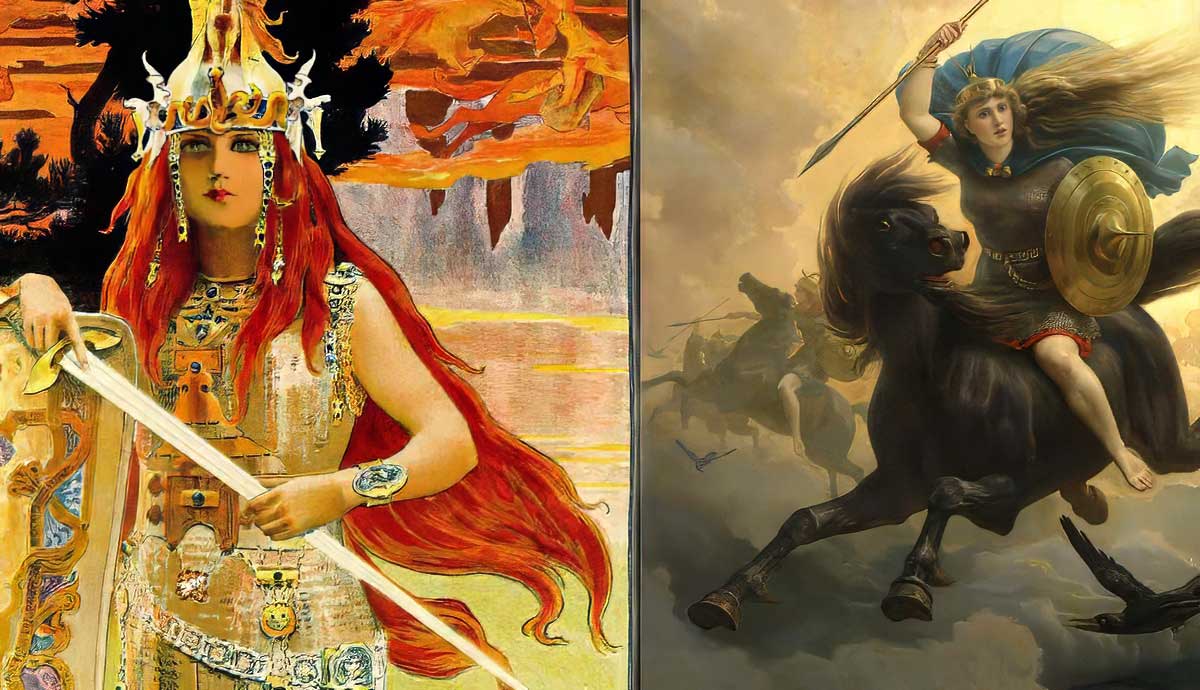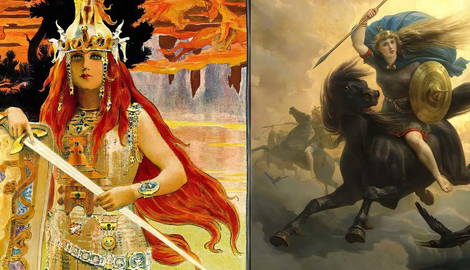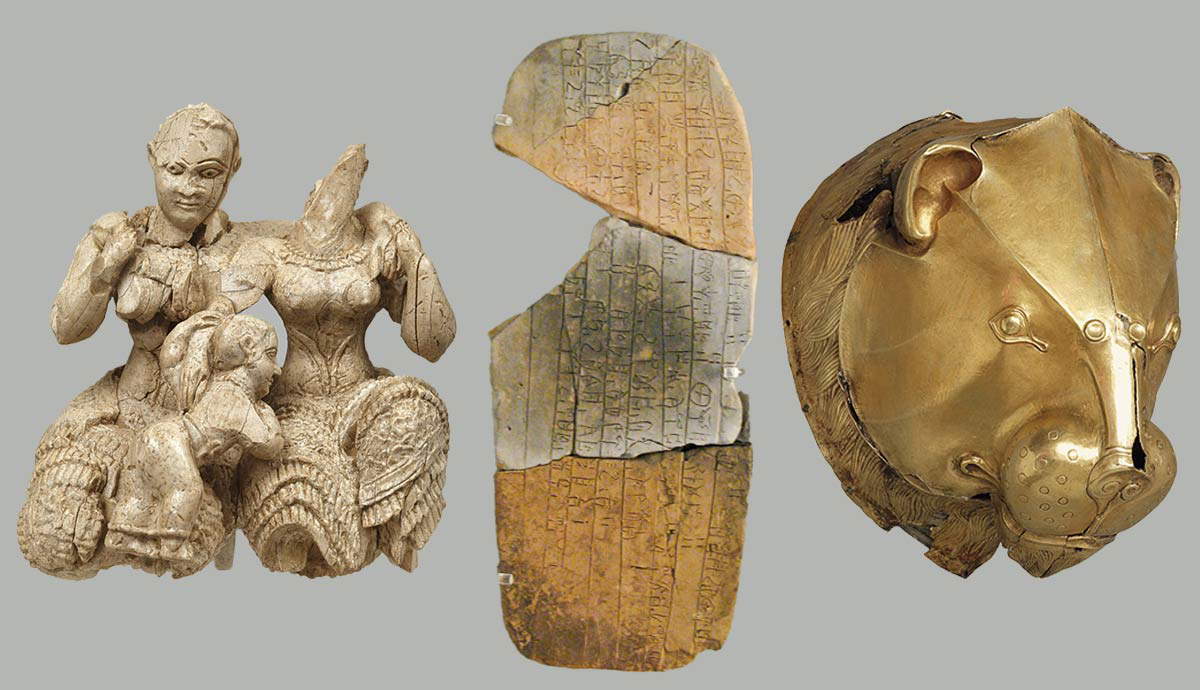
The Valkyries were divine shieldmaidens in the service of Odin, the All-Father. They helped the leader of the gods choose the bravest fallen warriors to dwell in the afterlife of Valhalla.
In Renaissance art, they are often depicted as beautiful and benevolent winged maidens carrying swords and round shields. But this is a very romantic image when compared to how they were described in the Viking Age.
In Norse sagas and Viking histories, Valkyries are beautiful, but also bloodthirsty. They reveled in the gore of the battlefield, entered the fray themselves to ensure the outcomes of wars, and even feasted on dead bodies.
Function of the Valkyries

In Old Norse, Valkyrie means “chooser of the slain.” This is a literal description of one of the roles of the Valkyries, a group of divine warrior women in the service of Odin.
The Valkyries helped the god of war choose the bravest fallen warriors on the battlefield to take to Valhalla, a hall in Asgard. There the warriors joined the ranks of the Einherjar, a cohort of worthy dead warriors, and trained to fight alongside the gods at Ragnarök.
The Valkyries were also sometimes called Oskmey, which means “wish maiden”. This reiterates their association with Odin, who was sometimes called Oski. What type of wishes they may have granted is unclear. Perhaps they fulfilled the wish of a warrior to be taken to Valhalla when they died.

The Valkyries were also sometimes called Rangahlin, which means “shield goddess.” They were closely associated with the Norns, the female Norse goddesses that spun fate.
In Njals Saga, one of the Icelandic sagas, a man witnesses a group of Valkyries weaving. But they use no ordinary loom. The heads of men are used as weights, their entrails as the warp and weft, a sword is used as the shuttle, and the reels are made from arrows. The writer observes that with this bloody work, they are choosing who will win an upcoming battle.
Other stories make it clear that Odin would send the Valkyries to the world of men to intervene in fights and ensure the proper outcome of battles. So, perhaps, the Valkyries could also grant the wish of victory in war.
Divine Demons

If you search for artworks depicting the Valkyries, you will find that they are popular subjects. They are often depicted as voluptuous and feminine women, mostly nude, but carrying shields. They appear as angelic warriors entering the fray on the side of good.
But if you read the descriptions of the Valkyries from the Viking Age, they appear much more like demons of death. The description of the group working at their bloody loom above is just one example.
While the Valkyries were all women, they wore chain mail that fell to the knee and helmets just like male warriors. They rode horses but also wore cloaks made from swan feathers. It was these cloaks that enabled them to fly.
When they appear over the battlefield, they are often described as shining brightly. When any of the gods appear to mortals they are often described as shining. They also carried spears, rather than swords or axes. This seems to be in imitation of Odin, who famously wielded the spear Gungnir.
But while they may have shone beautifully overhead like stars, the guttural battle cries made by the goddesses struck terror into the hearts of the warriors below. They were also described as reveling in the bloodshed they encountered. They would often pour more blood onto the battlefield, presumably implying that their presence made the battle more ferocious and increased the carnage.
After the battle, they would first feast on the bodies of their dead like carrion ravens or wolves (animals both associated with Odin), and bathe in the blood of the dead.

The only description of the Valkyries from the Viking Age that seems inconsistent with this bloody visage is the description of them serving meat and mead to the dead warriors in Valhalla. As cup-bearers, they fulfilled the same role as noble women in mortal households.
It is hard to imagine a Valkyrie bathing in blood and then meekly serving men mead. For this reason, some scholars have suggested that this function was added by later Christian authors to make the women more palatable. While this is possible, Viking Age sources also conflated the Valkyries with the daughters of kings and other noble women. This suggests that the roles of warrior and noblewoman could go hand in hand.
Identity of the Valkyries

The Valkyries are often described as traveling in groups of nine or twelve, but there doesn’t seem to have been a limit on the number of Valkyries. These numbers may represent a cohort that would fight together.
There is also a considerable blurring of lines between goddesses, Valkyries, and mortal women. This reflects the fact that the Vikings did not always draw clear lines between beings in the supernatural realm.
In various sources, we are given the names of many Valkyries. Their names almost always relate to war or battle. There is Hidlr (battle), Gunnr (war), Geirskogul (spear bearer), Goll (tumult), Hlokk (sound of battle), and Geirahod (spear fight).

Interestingly, we also meet Valkyries named Thrudr (power) and Freyja (lady). Thrudr and Freyja are both names of other goddesses, which suggests that some of the more important goddesses may also have numbered among the Valkyries.
Thrudr is the daughter of Thor, but little else is known about her. Freyja is a Vanir goddess who came to live in Asgard after the Aesir-Vanir war. She is a goddess of fertility, love, and beauty. She was one of the most important and popular Norse goddesses.
The sources suggest that just as Odin oversaw Valhalla, Freyja had her own arena, called Folkvanger, and that she also chose brave fallen warriors to dwell there. The sources even imply that she got first choice of the fallen. This seems to confirm a connection between Freyja and the Valkyries, but also reflects her greater importance.
Mortal Valkyries

At least some of the Valkyries were clearly considered goddesses. They are described among the gods in attendance at Balder’s funeral. But many mortal women are also described as Valkyries.
Perhaps the best-known example of mortal Valkyries comes from the Icelandic poem Volundarkvida. Three brothers meet three women who are spinning swan feather cloaks. This clearly identifies them as Valkyries, but they also have mortal identities. Two are the daughters of King Hlodver, named Hladgudr Scanhvit (swan white) and Hervor Alvitr (strange creature). The third is the daughter of Kjarr of Valland and is called Olrun (beer rune).
The three brothers take the women as wives, and they stay together for seven winters. But at that time, the women flew away to resume their work and never returned. Each man loses themselves as they set out to find their lost loves.
In another story, the son of a Norwegian king sees nine Valkyries riding past while he sits on a burial mound. His location may be significant as the Vikings believed that burial mounds could act as gateways between different realms.
The most beautiful of the Valkyries stops to talk to the man. She reveals that her name is Svava and she is the daughter of King Eylimi, who she often protects in battle. So again, she is given a mortal identity.
She gives the man a gift so that he can become a powerful king himself. When he is, he asks for Svava’s hand in marriage, which he receives. When he later dies in battle, the two are described as being reincarnated, which may imply that they start a new life in Valhalla.

On yet another occasion, a warrior Helgi meets a group of Valkyries on the battlefield and invites them back to spend the night with himself and his warriors. One of them, called Sigrun, explains that she cannot because she is betrothed to another man. She’s not happy about this because she considers the man unworthy.
Helgi then raises an army and goes to battle with the father of Sigrun’s betrothed to prevent the marriage. Once he is successful, with the help of the Valkyries, Helgi and Sigrun marry.
It is unclear what these stories mean about the nature of the Valkyries. The Danish author Saxo Grammaticus describes the shieldmaiden Vebjorg becoming a Valkyrie after she is killed in battle, suggesting that it is an afterlife occupation not dissimilar from that of the Einherjar. But Svava still seems to be alive when she is described as a Valkyrie since she still occupies her position in Viking society.
The Most Famous Valkyrie: Brunhild

The most famous Valkyrie is Brunhild. Her story was later immortalized in the operas of Wagner, but we first meet Brunhild in the Volsunga. Brunhild is commanded by Odin to intervene in a battle, but she strikes down the wrong king. Angered, Odin condemns Brunhild to marry a mortal man. This seems to be a very brutal punishment, and perhaps one that strips her of her divine status.
While Brunhild must submit to the punishment, she is incensed. Therefore, she says that she will only marry a man who can prove his bravery. Agreeing to her request, Odin places Brunhild on a mountain surrounded by a ring of fire and sends her to sleep. She will only accept a man brave enough to pass through the fire and awaken her.
The great Viking warrior Sigurd comes across Brunhild and awakens her. While the two fall in love, Sigurd says that he cannot marry her right now because he has too many things to do. He departs, promising to return. She says that she will marry the next man to awaken her, believing that it will be Sigurd. But as Sigurd continues his adventures, he is magically afflicted with amnesia. He forgets about Brunhild and marries someone else.
However, fate does take him to Brunhild’s stronghold again, this time with his friend Gunnar. They decide to win Brunhild for the single Gunnar, but he does not dare to pass the fire. So, Sigurd and Gunnar magically swap faces and Sigurd goes in his place.

Brunhild is still in love with Sigurd, but must marry Gunnar, as this is the condition of her punishment. She goes back to Gunnar’s kingdom, Gunnar and Sigurd restore their faces to one another, and Brunhild marries Gunnar.
Years later, Brunhild learns of the deception and decides to take revenge. She tricks Gunnar into killing his best friend in a ploy to punish both men. But Brunhild’s heart breaks when Sigurd dies and she throws herself on his funeral pyre to die by his side. But don’t feel too sorry for Brunhild — she also arranges to have Sigurd’s three-year-old son by his wife killed and placed on the funeral pyre.
At some point in their relationship, probably the first time they met, Sigurd and Brunhild made love. Brunhild became pregnant and gave birth to a daughter called Aslaug. According to legend, Aslaug would be fostered out and her identity kept a secret until she married the famous Danish warrior Ragnar Lodbrok. Aslaug was the mother of many of his sons, including Bjorn Ironside and Ivar the Boneless.











